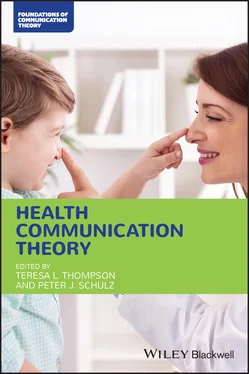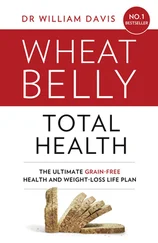Some of the conceptual constructs that frame health communication scholarship are not proper theories, per se, but function in ways similar to that which is found in theoretical scholarship. We elected to include them in Chapter 2by Brian L. Quick et al. that follows this introduction and occasionally throughout the other chapters. These variables/processes are frequently used to segment audiences and allow the adaptation of messages. They include notions such as tailoring and targeting health messages based on demographic, geographic, psychographic, and behavioral considerations. Other individual difference variables are also used and discussed in the chapter by Quick et al. Important amongst these are involvement, reactance proneness, locus of control, self‐monitoring, and sensation‐seeking. Health literacy is a key concept in much health communication research, although it is not specifically theoretical, so we have also added this notion into Chapter 2. This first section culminates with Jill Yamasaki’s chapter ( Chapter 3) on interpretive health communication scholarship. This chapter is appropriately called “When Theory and Methods Intertwine” because interpretive scholarship does not typically begin with a particular theory that is then tested, as is the case with the other theories discussed throughout the book. Yamasaki introduces several interpretive approaches to research that frame health communication theory.
As is common in books focusing on communication, we then move in Part IIto dyadic contexts and a discussion of the theories most commonly used in that area of health communication research. These dyadic contexts tend to be interpersonal in focus. Three theories are the focus of discussion in the following chapter ( Chapter 4) – communication accommodation theory, communication privacy management theory, and the theory of negotiated morality. Although these theories have different origins, they all illuminate interpersonal interaction as it relates to health and health care delivery. It should be noted that none of the theories are used exclusively in health and illness contexts, but they all have been applied extensively and fruitfully in health communication scholarship. This chapter is presented in an unusual manner, in that we had experts on the different theories write separate sections, with authorship of each section noted within the chapter. The authors of this chapter are Maria Brann, Jennifer J. Bute, Maureen Keeley, Sandra Petronio, Rachyl Pines, and Bernadette Watson.
Broadening the context a bit to the family, we move to four important theories that illuminate our understanding of how health processes operate within familial settings. Maureen Keeley and Hannah Jones’s chapter ( Chapter 5) discusses inconsistent nurturing as control theory, Olson’s circumplex model of marital and family systems, affection exchange theory, and the double ABCX model of family stress and coping. These theories have important implications for mental health concerns as well as physical health.
Still focusing on the interpersonal context is Peter J. Schulz and Shaohai Jiang’s discussion in Chapter 6of several theories that are important in the study of provider–patient interaction. We selected the following theories for this chapter: narrative medicine, politeness theory, dialectical tensions, the relational health communication competence model, the care model/productive interaction change approaches, and argumentation theory. Narrowing this chapter to the theories we selected was challenging because provider–patient communication is one of the dominant areas of study within health communication. This area of study, however, is the least theoretically based. Schulz and Jiang speculate on reasons for this limitation within the chapter.
Part III of the book broadens to a focus on persuasive communication, although this label should not be interpreted to imply that there is communication that does not have persuasive elements. Certainly, the theories prior to this section also pertain to persuasion in some ways. This section of the volume begins with Monique Mitchell Turner, Youjin Jang, and Shawn Turner’s discussion of information processing and cognitive theories ( Chapter 7), and includes a focus on the following theories: the risk information seeking and processing model; the risk perception attitude framework; PRISM (planned risk information seeking model); the health belief model and the reconceptualized health belief model; dual‐processing models; and attribution theory and attribution error. Moving to theories of affective impact, Robin Nabi outlines for us in Chapter 8the concept of psychological reactance; work on fear appeals and the extended parallel process model; and action tendency emotions.
A focus on behavior is then found in the chapter by Marco Yzer and Rebekah Nagler in Chapter 9of the book. This discussion is extensive and includes the following important theories: theory of normative social behavior; theory of planned behavior; theory of reasoned action; the integrative model; the transtheoretical/stages of change model; social cognitive theory; and the societal risk reduction motivation model. We conclude Part IIIwith a focus on message effects by James Robinson, Yan Tian, and Jeanine W. Turner ( Chapter 10). Their discussion emphasizes agenda setting; cultivation theory; inoculation effects; use and gratifications theory; narrative engagement theory; media complementarity theory; and framing theories (regulatory focus, construal level theory).
Part IV turns our focus to theories of organizations and society. We begin with Yanquin Liu and Anthony J. Roberto’s thorough discussion of sociopsychological theories in Chapter 11, which includes: the diffusion of innovations model; social judgment theory; self‐determination theory; and social comparison theory. None of these theories were originally developed to apply to health communication contexts, but all of them have come to play important roles in our understanding of such processes. Also taking a comprehensive focus is Chapter 12on public relations by Arunima Krishna. This chapter focuses on situational theory and organizational‐public relations theory. The reader will notice the broadening contexts of the chapters as the book moves toward its culmination.
Chapter 13, by Austin S. Babrow, Marianne S. Matthias, Sarah M. Parsloe, and Anne M. Stone, provides an insightful discussion of uncertainty management theories and health. These include the theory of motivated information management; uncertainty management theory; problematic integration theory, and harm reduction theory. As uncertainty management processes are fundamental to all health and illness contexts, these theories operate on the same broad level as do the other theories in this section. Also discussing theories at a broad, cultural level is Chapter 14, written by Evelyn Y. Ho and Barbara F. Scharf. This focus on cultural perspectives provides insightful analysis of the evolution of the study of health communication and the notion of culture as well as in‐depth discussion of social construction perspectives; ecological perspectives; culture‐centered approaches; the rhetoric of health and medicine; the cultural variance model; the communication theory of identity; critical approaches; and globalization theory.
The world in which we live requires an understanding of communication technology as it currently operates and will continue to change. To address this, Shyam Sundar and Maria D. Molina ( Chapter 15) discuss some key theories that frame research on digital information technologies in health communication. These important theories include the motivational technologies model; network influence; and gamification.
Danielle E. Kelley and Brian G. Southwell ( Chapter 16) conclude the volume for us with a focus on underdeveloped directions in health communication research. This chapter provides insight that will guide the work of health communication scholars and practitioners in the decades to come. As is implicit in this chapter and others throughout the book, ethical concerns are fundamental to all health communication research.
Читать дальше












